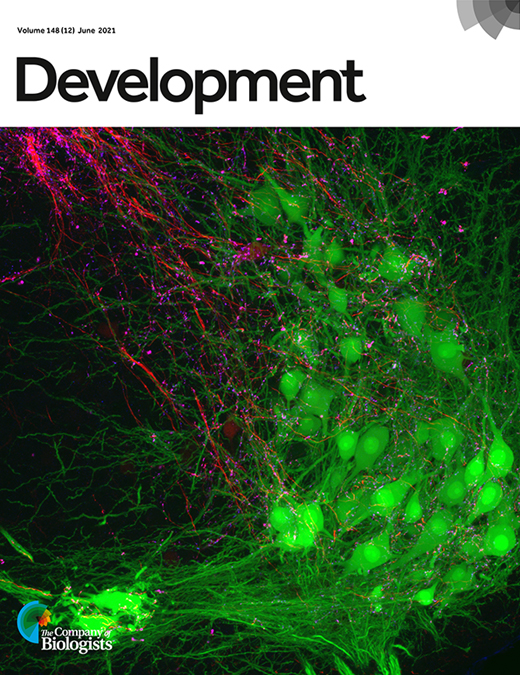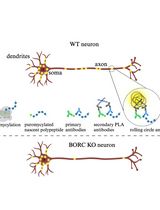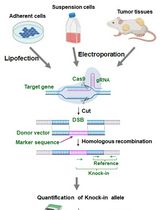- EN - English
- CN - 中文
Click-iT® Plus OPP Alexa Fluor® Protein Synthesis Assay in Embryonic Cells
在胚胎细胞中Click- iT®Plus OPP Alexa Fluor®蛋白合成分析
(*contributed equally to this work) 发布: 2022年06月05日第12卷第11期 DOI: 10.21769/BioProtoc.4441 浏览次数: 3054
评审: Giusy TornilloTien Anh NgoSilvia Olivera-Bravo
Abstract
This protocol describes a method to assess relative changes in the level of global protein synthesis in the preimplantation embryo using the Click-iT® Plus OPP Protein Synthesis Assays. In this assay, O-propargyl-puromycin (OPP), an analog of puromycin, is efficiently incorporated into the nascent polypeptide of newly translated proteins in embryonic cells. OPP is fluorescently labeled with a photostable Alexa FluorTM dye and detected with fluorescence microscopy. The intensity of the fluorescence is quantitatively analyzed. This is a fast, sensitive, and non-radioactive method for the detection of protein synthesis in early embryo development. It provides a tool for analyzing the temporal regulation of protein synthesis, as well as the effects of changes in the embryonic microenvironment, and pharmacological and genetic modulations of embryo development.
Graphical abstract:

Figure 1. Brief overview of the procedures of the Click-iT® Plus OPP Alexa Fluor® protein synthesis assay in embryonic cells. (A) Set up OPP treatments: (1) Set up microdrops containing 50 µL of OPP working solution and label different treatments on the back of culture dishes (e.g., T0, T1, T2, and T3); (2) The drops are overlain with 2–3 mm heavy paraffin oil and then equilibrated in incubator for 2 h; (3) Collect the embryos from female reproductive tracts or following in vitro culture in desired treatments; (4) Culture embryos in the equilibrated OPP working solution for 2–6 h. (B) Example of OPP detection procedures working with 60-well plates labeled as T0, T1, T2, T3, T4, and T5 for different treatments: (1) The first 60-well plate is used for the procedures of washing, fixation, permeabilization, and Click-iT® OPP detection. (2) The second 60-well plate is for DNA staining and washing. (C) Slide preparation: (1) Label the required number of slides and set up vaseline coverslip supports; (2) Add mounting medium; (3) Transfer embryos into mounting medium; (4) Set coverslip; (5) Seal the coverslip with nail polish.
Background
Fertilization triggers embryonic genome activation, whereby most maternal transcripts and proteins are degraded, followed by the generation of a new transcriptome and resulting proteome (Gao et al., 2017; Svoboda, 2018). These processes are required for the transition from maternal to embryonic control of development and create a cellular environment conducive of the totipotent state of the early embryo. There has been extensive analysis and development of tools for monitoring the changes to transcription at this time, but changes in translation have received less attention. New protein synthesis during the process of maternal to embryonic transition is tightly regulated and can be quantitatively evaluated with several methods, such as 35S-Methionine (Crosby et al., 1988), two-dimensional gel electrophoresis (Latham et al., 1991), and mass spectrometry (Gao et al., 2017). Here we report the development and use of a rapid alternative method for the analysis of global changes in the level of protein synthesis in the early embryo. The Click-iT® Plus OPP Protein Synthesis Assay is a non-toxic and non-radioactive method for the detection of nascent protein synthesis utilizing fluorescence microscopy and high-throughput imaging. O-propargyl-puromycin (OPP) is a membrane-permeable alkyne puromycin analog that forms covalent bonds with nascent polypeptide chains with cells. The addition of the Alexa Fluor® picolyl azide and the Click reaction reagents leads to a chemoselective ligation or “click” reaction between the picolyl azide dye and the alkyne OPP, and the modified proteins are detected by imaged-based analysis. The assay has been demonstrated to preserve cell morphology and has been used in NIH3T3, HeLa, C2C12 cells, BPAE, U-2 OS, CHO-M1, and A549 (Mateu-Regue et al., 2019; Enam et al., 2020; Liu et al., 2012), and the embryonic cells of preimplantation development (Li et al., 2021).
This protocol is designed to semi-quantitatively assess the relative changes in protein synthesis during the period of mouse maternal to embryonic transition. The first stage is to test and optimize the concentration of the OPP, then confirm the specificity of the assay by use of the known protein synthesis inhibitor Cycloheximide and inhibitor of translation elongation, 4EGI-1 (eIF4E inhibitor) (Li et al., 2021).
Materials and Reagents
Plastic and glass ware
60-well culture plates (Nunc, Naperville, IL, USA, LUX 5260)
35 cm × 10 mm Petri dishes (Thermo Scientific, catalog number: 150318)
Cover glasses, 18 × 18 mm (Merck, BR470045)
Microscope slides, 25 mm × 75 mm (Merck, S8902)
Animals
Six-eight-week-old female mice
Click-iT® Plus OPP Alexa Fluor® protein synthesis assay (Thermo Scientific, catalog number: C10456), including
Component A: Click-iT® OPP Reagent, 20 mM in DMSO
Component B: Alexa Fluor® 488 picolyl azide in DMSO solution
Component C: Click-iT® OPP Reaction Buffer (10× solution containing Tris-buffered saline)
Component D: Copper Protectant
Component E: Click-iT® Reaction Buffer Additive
Component F: Click-iT® Reaction Rise Buffer, containing 2 mM sodium azide.
Component G: NuclearMaskTM Blue Stain, 2,000× concentrate in water
Chemicals and reagents
Dulbecco′s Phosphate Buffered Saline (PBS) (Sigma, catalog number: D5773)
Triton X-100 (Sigma, catalog number: T8787)
Bovine serum albumin (BSA) (Sigma, catalog number: B2064)
Paraformaldehyde (PFA) (Sigma, catalog number: P6148)
DMSO (Sigma, catalog number: D8418)
Click-iT® Plus OPP Alexa Fluor® protein synthesis assay kit (see Recipes)
Fixation buffer (10 mL) (see Recipes)
1× PBS (50 mL) (see Recipes)
Permeabilization buffer (1 mL) (see Recipes)
Washing solution (10 mL) (see Recipes)
KSOM medium (see Recipes)
Equipment
Dissection microscope (Olympus, SZx7)
Nikon ECLIPSE 80i microscope, Plan Apo 40×/1.0 oil objective (Nikon, Tokyo, Japan)
pH meter SevenDirect SD20 (Mettler Toledo)
Incubator, Cytomat 2 C470-LiN (Themo Fisher Scientific)
Software
ImageJ (http://imagej.net/Fiji)
SPSS for Windows (Version 22.0, SPSS Inc., Chicago, IL, USA)
Procedure
文章信息
版权信息
© 2022 The Authors; exclusive licensee Bio-protocol LLC.
如何引用
Li, Y., Ji, X., Chang, L., Tang, J., Hua, M. M., Liu, J., O'Neill, C., Huang, X. and Jin, X. (2022). Click-iT® Plus OPP Alexa Fluor® Protein Synthesis Assay in Embryonic Cells. Bio-protocol 12(11): e4441. DOI: 10.21769/BioProtoc.4441.
分类
发育生物学 > 繁殖
干细胞 > 胚胎干细胞
生物化学 > 蛋白质 > 合成
您对这篇实验方法有问题吗?
在此处发布您的问题,我们将邀请本文作者来回答。同时,我们会将您的问题发布到Bio-protocol Exchange,以便寻求社区成员的帮助。
Share
Bluesky
X
Copy link












